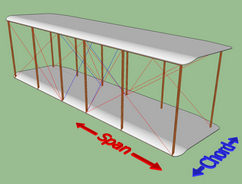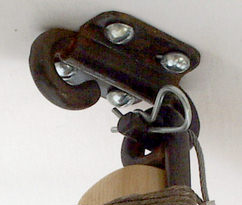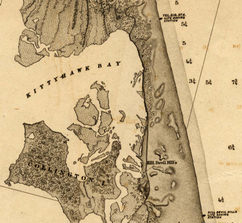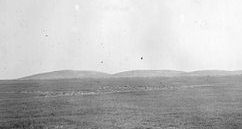|

 Up
Up 
 Kitty Hawk
Kitty Hawk

(You are here.)
 Down
Down




  Need
to Need
to
find your
bearings?
Try
these
navigation aids:
If
this is your first
visit, please stop by:
Something
to share?
Please:



|
|
Available in Française, Español, Português, Deutsch, Россию,
中文,
日本, and others.
 s
Wilbur and Orville labored over the design of their first glider in
the autumn
of 1899, they faced three major engineering tasks. First the wings had to generate
enough lift to support the weight of the glider and the pilot. For
this, they relied on the formulas and tables of data that
Lilienthal had
gathered during his lifetime. Will calculated that a biplane with a 20-foot
(6 meter) wingspan and a 5-foot (1.5 meter) chord – slightly larger
than
Chanute's glider – would do. He
planned a much flatter wing camber (curved shape) than Lilienthal,
however. Lilienthal had used a 1:12 camber – the wing curve was
1 inch high for ever 12 inches wide. Wilbur's kite experiments
likely taught him that wings with deep cambers were harder to
control than those with shallower curves. His camber would be just 1:20. s
Wilbur and Orville labored over the design of their first glider in
the autumn
of 1899, they faced three major engineering tasks. First the wings had to generate
enough lift to support the weight of the glider and the pilot. For
this, they relied on the formulas and tables of data that
Lilienthal had
gathered during his lifetime. Will calculated that a biplane with a 20-foot
(6 meter) wingspan and a 5-foot (1.5 meter) chord – slightly larger
than
Chanute's glider – would do. He
planned a much flatter wing camber (curved shape) than Lilienthal,
however. Lilienthal had used a 1:12 camber – the wing curve was
1 inch high for ever 12 inches wide. Wilbur's kite experiments
likely taught him that wings with deep cambers were harder to
control than those with shallower curves. His camber would be just 1:20.
Second, the wings had to be flexible so the
brothers could twist them. Chanute's glider had been completely
rigid along its span (wing tip to wing tip) and chord
(leading edge to trailing edge). The Wrights decided to brace their
machine along its span, but to only brace the chord of the middle
bay, where the pilot lay. This would allow them to twist the wings
along most of their length.
Finally, they had to add a control system –
a means for the pilot to move the aerodynamic control surfaces that
they hoped would balance and navigate the glider in the air. To
twist the wings, they ran cables from the wing tips to a kickbar
that they operated with their feet. They placed a horizontal elevator in front of the wings
(a
configuration that would later be called a canard) and simply lifted
or depressed the back edge with their hands. The completed aircraft
looked a lot like a Chanute-Herring glider with the tail in front.
 Tail First
Tail First
Rudderless
There was no rudder. In the time they had spent watching birds,
the Wrights had seen no evidence that a rudder was necessary to fly.
Birds had wings which they twisted to roll themselves right and
left, and and a flat horizontal tail that they used to pitch
themselves up and down. At this point in their experiments, the
brothers were convinced that all they needed to
navigate in the air was wing warping to turn and an elevator to adjust
altitude. They had missed something important, but would not
discover their mistake until they had some actual flying experience.
Although they opted to place their elevator in front of
wings, they did not completely dispense with the tail. Even
though they no longer planned to use it as a control surface, they
attached a tail to the back of the glider for stability -- and insurance.
Wilbur wrote to his father, "The tail of my machine is fixed and even
if the steering arrangement should fail, it would still leave me with the
same control that Lillienthal had at best." Wilbur thought that if
the horizontal elevator and the wing warping were not enough to balance
the glider in the air, he could revert to shifting his weight as
Lillienthal and Chanute had done.
Wind and Sand
The next question was where to fly it. Wilbur calculated that he
needed a steady wind of at least 15 miles per hour (24 kilometers
per hour) to get the craft airborne. He was also determined to make
his initial flights over sand or water to cushion the impact of a
possible (and extremely likely) crash. At first, he thought of the
Indiana Dunes where Chanute had flown his gliders and he wrote the
U.S. Weather Bureau for the average winds in the Chicago area from
August through September. (This was the off-season for the bicycle
business when the brothers could best afford to take some time off.)
The Bureau replied with a list showing the average wind velocities
in 150 cities throughout the United States.
 Safety Net
Safety Net
On 13 May 1900, Wilbur wrote to Octave Chanute at his home in
Chicago for advice, the beginning of a long and fruitful
correspondence. (To read Wilbur's first letter to Chanute, see
below.) Wilbur asked where he might find a sandy, windy location.
Chanute advised Wilbur to consider to consider San Diego, California
and St. James City, Florida. He also said "perhaps even better
locations can be found on the Atlantic coasts of South Carolina or
Georgia." Wilbur checked the material he had been sent by the Weather
Bureau. Sixth on the
list was an out-of-the way place in North Carolina with vast stretches of sand and water,
few trees, and relatively high winds. It was called Kitty Hawk.
Kitty Hawk
It was a tiny village on the North Carolinian barrier islands or
"outerbanks,"
long narrow strips of land just a few miles off
the Atlantic shore. They were entirely made of sand that had
accumulated as a result of the complex interaction between wave
action, sea level, and sediment. In the immediate area around
Kitty Hawk, the wind had whipped the sand into huge dunes, some of
them towering over 300 feet (91 meters). Just south of Kitty Hawk,
there were several especially high dunes known as Kill Devil Hills.
The average wind speeds for September were 16.3 mph (26.2 kph).
On 3 August 1900, Wilbur wrote the Weather Bureau office at Kitty Hawk, inquiring about the area.
Joseph J. Dosher, the single Weather Bureau employee at Kitty Hawk (also the
chief of the Life Saving Station) said they had a beach a mile wide without trees or other
obstructions. The winds in the autumn blew from the north or northeast.
Boarding was available in the village, but they would have to bring tents
for lodging. Dosher passed the letter to
Captain William Tate, the local notary, county commissioner, former postmaster,
and the only "banker" in Kitty Hawk who had been to high school. Tate sent
Wilbur a warm response.
"I will take pleasure in doing all I can for your convenience & success &
pleasure," wrote Tate, "& I assure you [that] you will find a hospitable
people when you come among us."

Bankers
|


Comparing the rigging of the 1896
Chanute-Herring Glider with the 1900 Wright Glider. Both have
bracing wires along the span (shown in red). However, every bay on
the Chanute is braced across its chord (blue), while on the
Wright, only the middle bay is braced.

To allow the wings to twist, the Wrights developed this unique
"hook-and-eye" hardware to attach the struts to the wings.

A coastal navigation chart from 1900, showing Kitty Hawk. The
location of Bill Tate's house and post office is circled.

In 1899, Kitty Hawk had about 250 residents, most
living on the "bay" side of the island.

Kill Devil Hills, just south of Kitty Hawk.

The Life Saving Station and Telegraph Signal Office
at Kitty Hawk, North Carolina was one of the very few structures on the
"ocean" side of the island. |